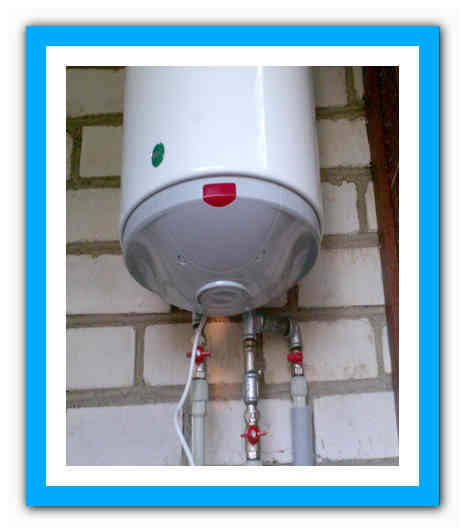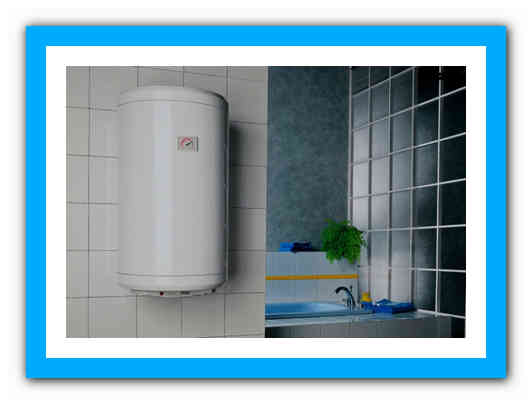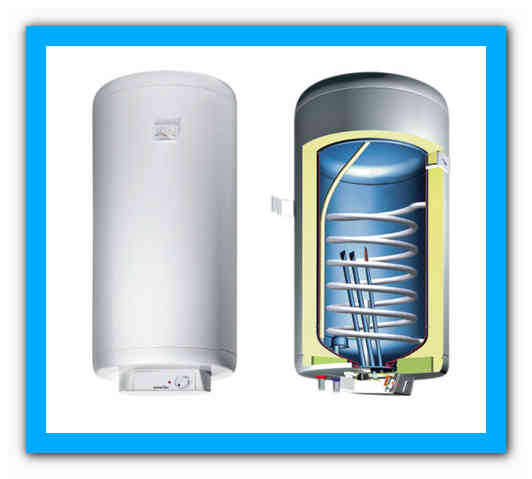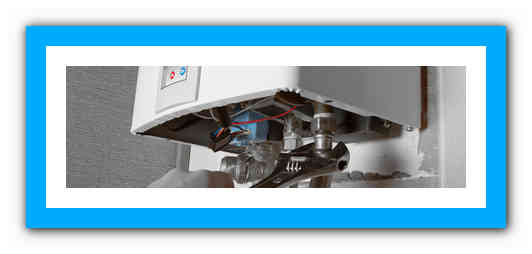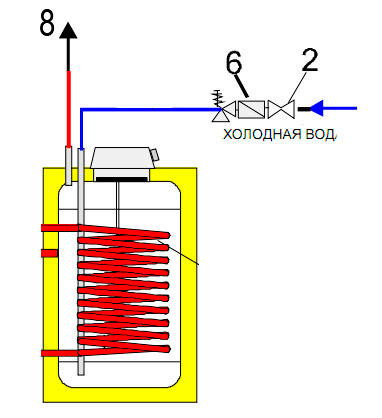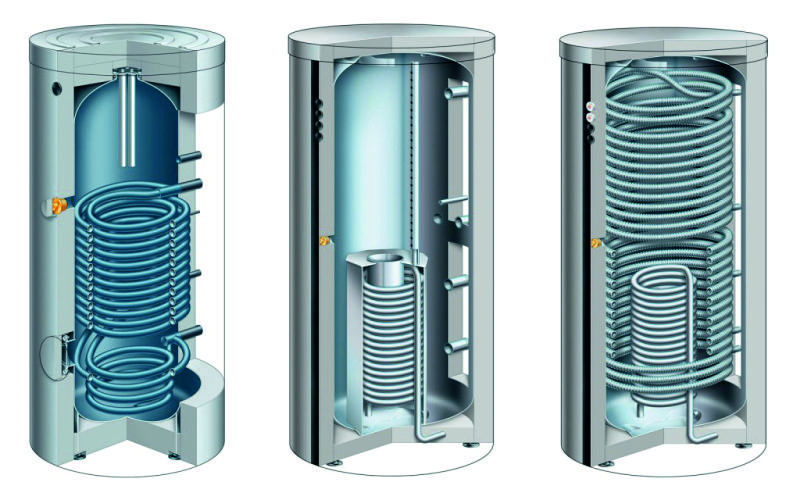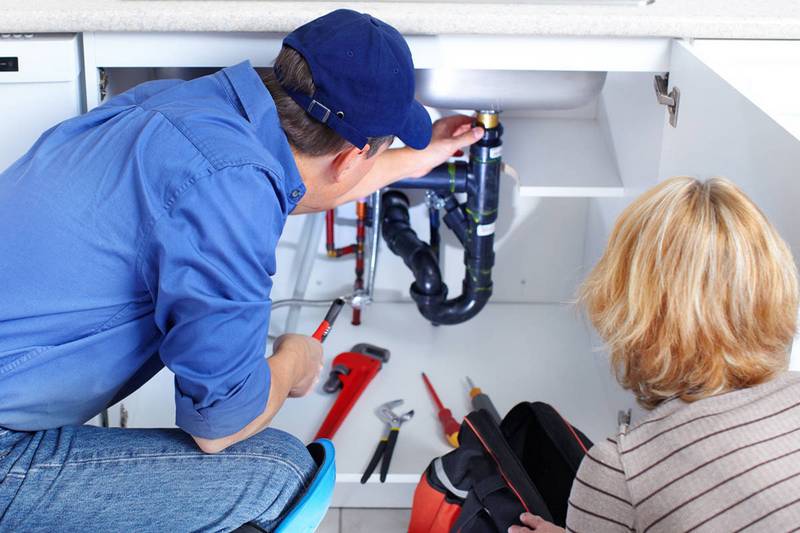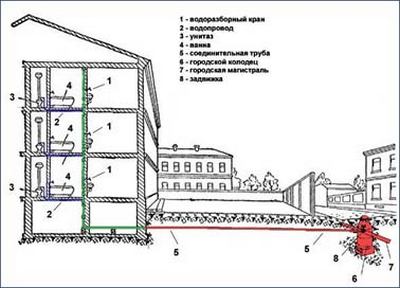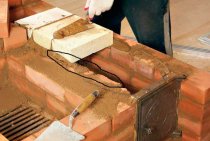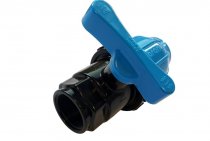What kind of water is sold to us
According to sanitary norms and rules for the provision of public services, the temperature of hot water in the house supplied to the residential premises of apartment buildings should not be lower than sixty degrees and not higher than seventy-five degrees.
At night, when there is almost no hot water consumption, its example is cooled almost to room temperature.
In the morning, the first residents, having opened the screen, are forced to pour water until the required temperature appears. This leads to unnecessary expense. To eliminate this drawback, an additional piping system is used to ensure constant circulation of hot water in the house. Circulation is carried out either by convection or by the use of additional circulation pumps.
Boiler for hot water supply.
All water heaters used to provide residential buildings with hot water are divided according to the method of heating into flow and storage (capacitive). By type of fuel, they are divided into electric, gas and solid fuel. In addition, boilers can use a direct, indirect or combined connection scheme.
In flow-through boilers, water is heated when it is directly parsed. In the accumulative, water is accumulated, which is heated by a heating element and then goes to the consumer. The DHW tank is equipped with a storage tank with thermal insulation, which affects its size.
If flow-through boilers are mounted in a "gap" of the pipeline, then the drives can be taken out to a separate room, which is due to the dimensions and installation method. Also, a storage water heater is produced in a vertical or horizontal type, while a flowing water heater is only horizontal.
The principle of operation of the device.
A hot water boiler provides the consumer with a large amount of hot water at different points in the home. For this, a heating element (heater or wire) is mounted in the housing. Cold water enters the device at nominal pressure, heats up (in a container or in a flow) and, when parsed, reaches the consumer. The temperature can vary from 50 to 75 degrees (depending on settings and adjustments). Accordingly, when the boiler is placed above the mixers and other collapsible points, the device also begins to work as a hydraulic accumulator. But this is possible only when using a storage water heater.
The power of the unit must be selected based on the capabilities of the local electrical network.
If the boiler power is insufficient, the time for heating the water to the desired temperature will increase.
Indirect and combined connection scheme.
Such systems have proven themselves well in the private sector. With an indirect scheme, the boiler plays the role of additional equipment, and the main element is a double-circuit gas boiler. The water heated by the boiler enters the device, where it is “warmed up” and supplied to the consumer. Otherwise, it circulates through the system at a given temperature, which the boiler provides.
The combined scheme is similar to the indirect one. The differences are that the boiler is the main heating device along with the boiler. Those. water can be heated both gas and electric. Such a scheme is convenient in case of possible interruptions with the receipt of a particular resource.
Features of operation.
Any water heater needs ongoing maintenance. Basically, this is a consequence of his work, when there is an interaction of water and electricity. In this regard, scale is formed, which has a detrimental effect on the heating element and the inner walls of the tank or housing. Therefore, it is necessary to clean the device chemically or mechanically. It is recommended to carry out such a procedure every 2-3 years.
The presence of suspensions and contaminants in the water also affect the heater. To eliminate these problems, it is advised to install a coarse filter. He will detain large fractions, not letting them into the boiler. Accordingly, the filter itself needs to be cleaned at least once a year.
Purpose and principle of operation of the elevator unit
It was said above that the water in the heating system of a multi-storey building is heated to 130 degrees. But consumers do not need such a temperature, and it is absolutely pointless to heat the batteries to such a value, regardless of the number of floors: the heating system of a nine-story building in this case will not differ from any other. Everything is explained quite simply: the heating supply in multi-storey buildings is completed by a device that goes into the return circuit, which is called an elevator unit. What is the meaning of this node, and what functions are assigned to it?
In addition, through the same channel, the liquid enters the heating system for recirculation. All these processes together make it possible to mix the coolant, bringing it to the optimum temperature, which is sufficient to heat all apartments. The use of an elevator node in the scheme allows you to provide the highest quality heating in high-rise buildings, regardless of the number of storeys.
The principle of operation of boilers
Electric water heaters and indirect heating boilers heat water using heating elements or coils through which the coolant flows. The water in the tank is under pressure and is supplied through the inlet pipe - it is connected through the reverse valve to the water supply. After turning on the water heater in the outlet (or opening the coolant supply), you must set the desired heating temperature and wait until the desired temperature is reached.
Usually, cold water enters the tank from the bottom, as it heats up, hot water rises, from where it enters the hot water supply.
Temperature control is carried out using a thermometer. As soon as the water heats up, the device will automatically stop heating it. Further, the temperature will be maintained by thermal insulation. It is worth opening the tap - and hot water will flow from it. The missing volume will be instantly replaced by cold water. As soon as the temperature in the tank falls below the allowable mark, the heating will automatically turn on.
The principle of operation of the boiler is very simple - it heats the water and maintains its temperature, including heating as needed. And in order to ensure the stability of the outlet temperature, hot water is taken from the top of the tank, as hot water rises. As for the supply of cold water, it is carried out from below - there it heats up and mixes itself with the already prepared water. All this makes it possible to ensure an almost continuous supply of hot water to consumers.
- 05/08/18 Date added 1190 Views 5.0 Rating
In the modern world, there are a huge number of different water heaters that differ in their design and principle of operation, so it will be very difficult for a person who is far from this area to choose a quality boiler. It is in this case that this article will help you.
Risers of the water supply system

Risers - vertical arrangement of pipes in the water supply system.
They are divided into three types:
- heating riser;
- Water supply riser;
- Sewer stand.
Maintenance of such installations is provided by representatives of such organizations as ZhEK, ZhES and others serving the house.
Consider some legal aspects:
- The management company is obliged to ensure the serviceability of communications of a residential apartment building. Therefore, the organization must replace the risers at its own expense (if we are talking about pipes that have become unusable after their useful operating life has expired);
- The city or district administration is obliged to replace the risers in the municipal building;
- In the event that communication systems are privatized, the residents pay for the repair work.
In some cases, responsible persons try to evade their duties or demand money for the work done.
In this case, it is necessary to achieve the fulfillment of their direct duties by responsible persons. An official application must be completed and submitted. If there is no reaction, a complaint is written to the housing department. As a rule, such actions are quite enough to restore justice.
Water heating devices
There are four types of water heaters: according to the principle of operation - accumulative and flow-through, and according to the fuel used - gas or electric.
Electric storage water heater
It consists of a container with a heating element placed in a special casing. Thermal insulation is laid between the tank and the casing. The water heats up to eighty-five degrees. The water temperature is regulated by built-in control systems. After full heating, the water temperature is maintained using a thermostat, by turning the heaters on and off. The capacity of such water heaters is from 10 to 300 liters and power from 1.5 to 3 kW. This volume is quite enough to provide warm water to a family of three to four people.
Instantaneous electric water heater
A water heater of this type is often used in a private house to produce hot water. The design of the water heater is different in that it does not have a storage tank. When the tap is opened, water immediately flows to the user. The temperature of water heating - from 500C to 900C - is reached within a few seconds. Such water heaters are quite energy-intensive - from 5 to s kW. Their positive properties are considered to be high productivity.
Water heater gas accumulative
According to their design, such heaters are floor and wall. Floor - usually used in small enterprises. Tank capacity from 200 to 2000 liters.
Wall-mounted water heaters are used in rooms where a family of three to four lives. Tank capacity from ten to one hundred liters. Typically, these heaters use natural gas to heat water, but occasionally there are devices that run on propane.
Instantaneous gas water heater
Almost simultaneously with the opening of the tap, hot water flows. In such devices, gas is ignited in several ways:
- with the help of matches;
- piezo ignition;
- electronic ignition;
- from a hydro generator;
The design of combined water heaters provides for the installation of several types of heating elements. Such a device provides an uninterrupted supply of hot water.
Sewerage
The domestic sewerage system is designed to drain waste from sanitary appliances. Sewer network risers (K1) are made of PE80 SDR41 polyethylene pipes in accordance with GOST 18599-2001. To compensate for temperature elongations on plastic risers, expansion pipes are provided every 3 m. Electric potential equalizers from metal bathtubs and shower trays are connected with a copper drive PV 3-1-4 to ground risers (see EM sheets). Bring the exhaust part of the K1 system 0.1 m above the edge of the ventilation shaft.
The network of internal drains is designed to drain rainwater from the roof of the building to the external network of storm sewers. To prevent freezing of the funnels and the section of the pipeline laid along the technical site, their electric heating is provided. The network in the attic is mounted from steel electric pipes according to. The riser and outlet are mounted from PE80 SDR17 polyethylene pipes in accordance with GOST 18599-2001. Steel pipes are coated with oil paint for 2 times.
Varieties of pipes for the plumbing system
At the moment, these types of pipes are used in the central water supply network, which is indicated in the diagram:
- Steel pipes. At present, steel pipes are practically not used. This is due to the availability of less costly alternatives to them. The cost of steel pipes is much higher than that of other types. At the same time, installation work also requires additional financial costs, and in addition, it will require a lot of time and effort. The biggest disadvantage of steel pipes is the collection of condensate, which directly destroys the material. Over time, rust and scale will appear inside the system, reducing the diameter of the pipeline, which will lead to a decrease in throughput.
- Copper pipes. This variety has a long service life, reaching an average of half a century. Copper pipes also have a high cost, but they do not rust. Moreover, they have disinfecting properties.
- Metal pipes. Plastic pipes, which are practical and reliable, are in great demand in the modern world. Their installation is quite easy and does not require much time. But you will need special tools. Pipes are connected using fittings. The plastic pipe is characterized by high mechanical and physical loads.
Description of the closed heating system
In recent years, the use of a closed water supply scheme has become increasingly popular. The closed system is based on the use of a heating main with a completely separate, autonomous circuit, into which cold water is pumped for subsequent passage through heat exchangers.
The latter, however, take heat from the main water, which is heated in a CHPP. In addition, other heat sources are available, but the most common among them is the direct transfer of heat from an open hot water supply.
In this case, the quality of the hot water supplied to the house does not depend on the condition of the pipes that the central heating system has in itself. The closed scheme implies the use of heat exchangers and additional pumping units.
A closed-type hot water supply system has undeniable advantages compared to an open one: quality indicators and bacteriological properties.
The closed hot water supply circuit ensures a stable temperature regime, regardless of the air temperature in the winter.
Modern engineers are increasingly resorting to the use of a closed-type system, since this scheme is characterized by the highest reliability for consumers.
The pipeline for hot centralized water supply cannot be made according to the cold water supply scheme. These pipelines are dead-end, that is, they end at the last draw-off point. If you make a hot water supply in an apartment building according to the same scheme, then the water at night, when it is little used, will cool down in the pipeline. In addition, there may be such a situation, for example, residents of a five-story building located on the same riser went to work during the day, the water in the riser cools down and suddenly one of the residents on the fifth floor needed hot water. After turning on the tap, you will first have to drain all cold water from the riser, wait for warm, and then hot water - this is an excessively high consumption. Therefore, hot water pipelines are made looped: water is heated in the boiler room, heating unit or boiler room and is supplied through the supply pipeline to consumers and returned back to the boiler room through another pipeline, which in this case is called circulation.
In a centralized hot water supply system, piping in the house is carried out with two-pipe and one-pipe risers (Fig. 111).
Rice.111. Schemes of hot water distribution in centralized systems
The two-pipe hot water supply system consists of two risers, one of which supplies water, the other drains. Heating devices - heated towel rails are placed on the outlet circulation riser. The water was heated anyway and served to consumers, but it is not known whether they will use it or not and at what time, so why waste it, let this water heat the heated towel rails and the air in, by definition, damp bathrooms. In addition, heated towel rails serve as a U-shaped compensator for thermal expansion of pipes.
A single-pipe hot water supply system differs from a two-pipe one in that in it all circulation risers (within one section of the house) were combined into one and this riser was called “idle” (it has no consumers). For better water distribution to individual points of water consumption, as well as in order to maintain the same diameters over the entire height of the building in single-pipe hot water supply systems, risers are looped. With a ring scheme for buildings up to 5 floors inclusive, the diameters of the risers are 25 mm, and for buildings from 6 floors and above - 32 mm in diameter. Heated towel rails in single-pipe wiring are placed on supply risers, which means that with weak heating of water in boiler rooms, it can reach distant consumers cooled down. Hot water will not only be disassembled by nearby consumers, but it will also cool in their heated towel rails. In order for the water not to cool down and reach hot to remote consumers, a bypass is cut into the heated towel rails.
Two- and one-pipe hot water systems can be made without heated towel rails, but then these devices must be connected to the heating system. At the same time, heated towel rails will not work in summer, and in winter, the total cost of hot water supply and heating will increase.
To ensure air removal from the system, pipes are laid with a slope of at least 0.002 to the pipeline entry. In systems with lower wiring, air is removed through the upper water tap. In the case of top distribution, air is removed through automatic air vents installed at the highest points of the systems.
There are three types of hot water systems
Open - when the consumer uses water through taps from the general water supply system as the heating system, that is, directly the coolant itself.
Closed - when cold drinking water is heated in a special heat exchanger, that is, cold water and coolant do not come into contact with each other.
Independent - when cold water, after being heated at a heating point, enters the consumer through a separate piping system.
Multi-story houses
To meet the needs of residents of multi-storey buildings in hot water, special devices for heating water are being built - heating points. This is a whole complex of parts and assemblies, power plants that provide heating, operating modes and distribution of water depending on the types of consumption.
Hot water in a multi-storey building is created either by an individual heat point - for one house, located in the basement or on the roof, or central - for several houses, located in a separate building.
Private houses
Hot water in a private house is, of course, convenience and comfort. To obtain warm water, you can use several methods, including a water heater.
When selecting a water heater, it is necessary to take into account the workload of the hot water supply system and the number of screens for water extraction. The choice of equipment is made taking into account the fuel used for the operation of the system. Gas is considered the most acceptable for this.
country houses
Hot water in a country house is the main condition for comfortable living.
Like all communications in a country house, the hot water supply system must be carefully designed.
Usually in a country house a combined water heating system is used, that is, a boiler and a boiler. Boilers are devices for indirect water heating. They differ in volume and power, which allows you to choose the necessary water heater depending on the number of people living in the house, the number of taps, the required amount of water for technological needs and the rapid provision of residents with hot water.
Features of supplying hot water to a residential building

The hot water supply system in the house includes two types of wiring - lower and upper.
To maintain the optimal temperature regime in the pipeline, looped wiring is often used. With the help of gravity pressure, water circulation in the ring is ensured, even in the absence of water intake.
In the riser, water is cooled and directly enters the heating unit. With an even higher temperature, water is supplied through pipes. Thus, a continuous process of circulation of the coolant is carried out.
In addition, the hot water supply system is divided according to some features:
- local;
- Centralized;
- Open thermal;
- closed thermal.
Faults
What violations in the operation of the water supply system can the owner of the apartment eliminate on his own? Here are some of the most typical situations.
Leaking valves
Description: leak on the stem of screw valves.

- Reason: partial wear of the oil seal or wear of the rubber sealing ring.
- Solution: open the valve knob as far as it will go. In this case, the thread on the rod will press the stuffing box from below, and the flow will stop.
Noise of cranes
Description: when opening a hot or (more rarely) cold water tap, a loud noise is heard and the mixer is vibrating. Alternatively, your neighbor's faucet may be the source of the noise.

Cause: a deformed and crushed gasket on a screw valve box in a half-open position causes a continuous series of water hammers. Its valve closes the seat in the mixer body with a frequency of fractions of a second. On hot water, the pressure, as a rule, is noticeably greater, so the effect is more pronounced on it.
Solution:
- Turn off the water to the apartment;
- Unscrew the problematic crankbox;
- Replace the gasket with a new one;
- Remove the chamfer from the new gasket with scissors. The chamfered face will prevent the valve from beating in the turbulent water jet in the future.


Cold towel warmer
-
Description
: The heated towel rail in your bathroom is cold and does not heat up. -
Cause
: if the water supply scheme of a residential apartment building uses continuous circulation of hot water, the air remaining in the jumper between the risers after the water is discharged is to blame (for example, for revision and repair of valves). -
Solution
: go up to the top floor and ask your neighbors to bleed air from the jumper between the hot water risers and heated towel rails.
If for some reason this is not possible, the problem can be solved from the basement:
- Shut off the DHW riser passing through your apartment, to which your connections are connected;
- Climb into the apartment and open the hot water taps to failure;
- After all the air comes out of the riser through them, close the taps and open the tap on the riser.


Domestic plumbing
An internal plumbing is a system through which water moves. For the household needs of the population, water through water-folding devices from local rivers and lakes, less often from underground sources. The untreated water then enters a collection well and is pumped to a treatment plant where it is filtered, settled and undergoes complex purification processes before being delivered directly to the consumer.After all stages of the purification process, the water is pumped to water towers, and from there it rushes along highways to city networks, which in turn bring it directly to residential buildings. All this is called internal plumbing.
Let's analyze in more detail the internal plumbing.
So water entered the house. In the basement, immediately behind the wall of an apartment building, a water meter assembly is installed, consisting of a water meter with two valves, a control (bleed) valve and a bypass line equipped with a sealed valve. From the city water supply network, water enters the in-house water supply system. The cold water supply system in an apartment building, as a rule, is arranged with a lower wiring, i.e. The distributing pipeline is located in the basement of the house. The pressure created by the hydraulic regime on external networks delivers water through the internal system to the upper floors of the house. That is, water is supplied to the house under pressure. Until recently, pipes for the delivery of water were used cast iron or steel. However, due to their fragility, polypropylene pipes are increasingly being used. Shut-off valves are installed on the pipeline. It is used in order to be able to easily block the pipe section for its replacement or in the event of an emergency. Installation of the internal water supply system is carried out simultaneously with the installation of the sewer system. First of all, according to special projects, the main distributing pipelines are mounted in the basement of the house. The question may arise, due to which the water supply pipelines are attached in the basement of the house and along the entire length of the riser. Pipes are attached to building structures using clamps, brackets, hooks and brackets. In order for pipes to pass through ceilings, walls and partitions from pieces of pipes or steel make passages along the diameter of the pipes. From the main pipelines in the basement of the house there are risers, and already from the risers there are supplies to the so-called water points. These are taps, faucets in the bathroom, toilet, kitchen, washing machines and dishwashers, etc. Ultimately, the consumer opens the faucet and water flows from it.
The water supply of a residential building, in turn, is divided into cold and hot, but more on that in more detail.
